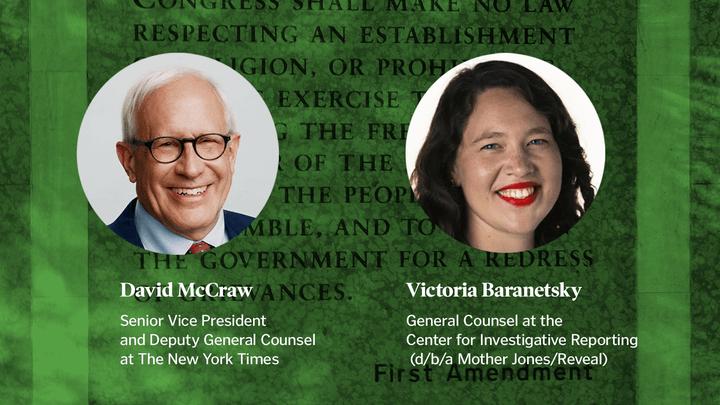Reproductive health is a multi-beat topic in the daily news cycle, and yet coverage of abortion so often falls short.
In terms of sheer newsworthiness, there has been more abortion-related legislative activity in recent years than any period of time since the landmark 1973 U.S. Supreme Court ruling Roe v. Wade. Abortion-related bills are introduced, debated and voted on nearly daily in state legislatures across the country. Some of this legislation is unconstitutional, which fills the courts with abortion-related cases.
Beyond legislation and litigation, abortion is perpetually re-centered as ground zero in the culture wars. Every election season, it’s a lightning-rod word that rockets into headlines, usually with scant examination of what policy changes would actually mean for constituents.
Globally, abortion-related injuries sustained in places where the procedure is illegal is a leading cause of maternal mortality. And we know that prior to Roe v. Wade in 1973, many American women were injured, and died, trying to access abortion, with women of color disproportionately suffering the damage.
Yet, despite all this newsworthiness and the very high stakes, abortion coverage continuously falls short in frequency, accuracy and quality.
Why is covering abortion so hard to get right?
A new study digs into that question by analyzing the news-making process when the subject is abortion.
In “The stakes are so high: Interviews with progressive journalists reporting on abortion,” published this month in peer-reviewed journal Contraception, researchers interviewed 31 reporters with experience at 75 diverse outlets to examine how journalists experience the process of covering abortion. The study was designed to build on previous research, “Shaping stigma: An analysis of mainstream print and online news coverage of abortion, 2014-2015.”
Participating journalists were recruited through “progressive” and “feminist” listservs. Only a few of the participants described abortion or reproductive health as their primary beat. Most interviewees were white, based in the Northeast, and female, living in households of wide-ranging income. (Even though most participants were white, the percentage was lower than the average pool of reporters).
Researchers found several major obstacles in covering abortion-related topics.
The first obstacle addressed is navigating a demand for “both sides” neutrality when reporting on a subject where demonstrably false information is commonly offered as talking points.
“[Editors] are always saying, 'You need to talk to the National Right to Life if you’re going to talk to the Planned Parenthood Action Fund,'” says study participant and reporter 31-year-old Miriam.
A “both sides” framework rewards advocates and activists willing to offer false information as a legitimate opposing perspective. In other words, it favors propaganda.
Participants perceived more pressure to be “balanced” when reporting on abortion compared to covering other issues. “The journalistic trope of ‘fairness and balance’ seems to mean simply quoting people saying falsehoods,” said 69-year-old Corrine. “You accurately quoted a bunch of lies.”
Perhaps because the abortion debate is so saturated with false information, one-third of the participants chose to interpret balance as a "competition of merit," despite the pressure.
The competing-merit framework is almost radical in its simplicity. Most abortion-related legislation is state level, often based on boilerplate bills. In all likelihood, another state has already passed a bill similar to the one being reported. That means relevant information, such as abortion complication stats, or the number of clinics forced to close, is available.
Another merit-based line of inquiry would be to interview public health officials and doctors. Reporters can also trace the genesis of the legislation, and assess the source.
Of course, such reporting takes more time and expertise than simply juxtaposing two statements. And unfortunately, given the demand for quick-hit stories in a 24-hour digital news cycle and the severe shrinking of statehouse reporters, time and expertise are increasingly precious resources.
Reporting on abortion takes initiative. Participants reported having to pitch editors, rather than being assigned, stories. They often had to educate their editors, too.
Given the myths that permeate the abortion debate, it’s unsurprising that editors —disproportionately white men — would lack basic knowledge about abortion as a medical procedure.
“It was very clear the editor thought … abortion required something akin to major surgery,” said Brenna, 41. “There are a lot of assumptions that they bring to editing that are not born out in what we know about abortion.”
More than one-third of participants cited finding new voices and angles as an obstacle to covering abortion. For all their differences, one thing that pro-choice and anti-choice communities may have in common is relying on talking points shared across coalitions, which can make for predictable stories.
While it’s easy enough to suggest reporters seek to interview medical professionals and women who have had abortions, the reality is that stigma and harassment can prevent such sources from going on the record.
Here, it’s important to note that reports of targeted harassment of abortion providers has risen dramatically in the past two years in the wake of discredited anti-Planned Parenthood propaganda videos published by a radical anti-abortion activist currently facing felony charges in California. Since the videos, even scientists using fetal tissue while conducting life-saving medical research have been intimidated into silence.
Facing harassment for just reporting on abortion is the single most common experience of all surveyed journalists. Twenty-four of 31 participants reported harassment ranging from “nasty tweets” to “death threats.”
In their conclusion, the researchers note the survey participants do not reflect demographics of the U.S. reporter pool at large, though it is unclear if that disparity can be attributed to the researchers’ recruitment methods, or if journalists covering abortion differ from the demographics of newsmaking professionals at large, or both.
The answer matters. “[If] journalists who cover abortion are demographically distinct from other journalists, particularly with regards to gender, there are a number of potential consequences to be explored: the framing of abortion as a ‘niche’ women’s issue, the associating of abortion with the challenges of lower-prestige, lower-paid reporting that many journalists face, and the high rates of harassment which are generally reported more frequently by women journalists than their male colleagues.”
Anyone paying attention can tell you that most reporters covering abortion are women. In my personal experience as a reporter covering abortion, I experienced and observed the double stigma of being a woman covering an issue that disproportionately affects women. I recall being warned on more than one occasion that I was pigeon-holing myself. I felt the work was sometimes pink-washed, as if pursuing investigative evidence-based reporting of a controversial issue with high stakes was soft work, simply because it most directly affects women’s lives.
With new insight into the obstacles of covering abortion effectively, we can work toward remedies. Clearly newsrooms (and perhaps, Twitter) need to do more to address harassment. Advocates should see, and seize, the opportunity to fill the knowledge gaps created by shrinking, non-diverse newsrooms by pro-actively educating reporters and editors.
For all of our journalist navel-gazing, it’s refreshing that there are some answers to be found outside of ourselves. What other subjects could we benefit from interviewing journalists to find the obstacles in the newsmaking process?






